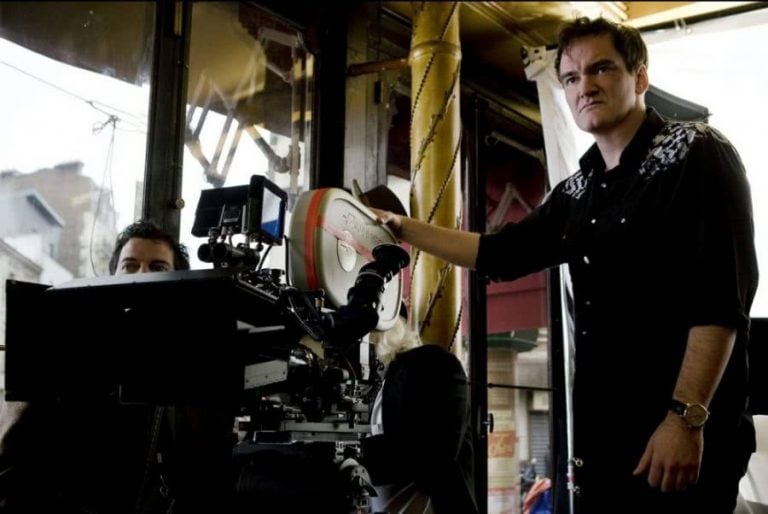What do the Holocaust, slavery in Southern America, and the Manson family murders have in common? Aside from being unthinkable acts of human cruelty, they’ve all received, or are receiving, the Tarantino treatment. The third, a take on the crimes of Charles Manson and his cult followers, is scheduled for release in 2019 and tentatively titled Helter Skelter.
The former two are Inglourious Basterds (2009) and Django Unchained (2012) respectively. Both are stylish, hugely successful, and both, to varying degrees, are based on untruths – in a sense they are alternate histories.
The Nature Of Revenge
In Inglourious Basterds, an irreverent tale of Jewish resistance to the Holocaust, the point at which the film forks away from true history is clear. Django Unchained is a much more intimate story; a freed slave-turned-bounty hunter seeks vengeance whilst on the quest to find and liberate his wife, Broomhilda. There is no dramatic forking of history in Django Unchained; the hero does not singlehandedly bring an end to slavery in the same way that the Basterds arguably bring an end to World War II. But the film still draws on the horror of Black enslavement to tell a high-camp story of liberation and revenge that ostensibly didn’t happen.
Tarantino has made a name for himself over his long and celebrated career, particularly in relation to style. His films are graphically violent and draw on numerous cultural references and nods to pulp-cinema. He’s also a divisive figure; few people are ambivalent about Tarantino. However, as the focus of his films has gradually shifted from intimate personal narratives to the high-stakes theatre of world history, both the films and Tarantino himself have come under greater scrutiny.
Exactly what place Inglourious Basterds and Django Unchained hold in the canon of politically conscious cinema isn’t entirely clear. Both films are swashbuckling tales, full of extreme violence usually perpetrated against the oppressors. However, one may ask about the value of their cultural contribution if the stories they tell within the context of these events – particularly given said events have caused such significant generational trauma –didn’t actually happen.
For example, in Inglourious Basterds a renegade gang of Jewish Americans, called the Basterds, are airdropped behind enemy lines to assist with a plan to assassinate Adolf Hitler. They are a motley crew assembled due to their proclivity for killing Nazis, and fronted by Aldo “the Apache” Raine, a former moonshiner from Tennessee, played by Brad Pitt. One member in particular causes the Germans to shake in fear: the Bear Jew, played by Eli Roth, given his name after repeatedly beating Nazi soldiers to death with a baseball bat.
https://www.youtube.com/watch?v=6AtLlVNsuAc
At the same time, a young Jewish woman, Shoshanna Dreyfus, has forged a new identity as a Parisian cinema owner after narrowly escaping the murder of her family at the hands of a master “Jew Hunter” named Landa played by Christoph Waltz. When Reich Minister for Propaganda Joseph Goebbels insists that the premiere of the latest German war film take place in her cinema, she hatches her own plot to burn the cinema down, killing the Nazi high command in the process.
As it happens, both plots are not only successful but occur simultaneously. Shoshanna burns the theatre down, and the Basterds are able to infiltrate the premier, but only after the nihilistic Landa agrees not to foil their plan in exchange for indemnity.
There is something deeply surreal about watching Adolf Hitler and Joseph Goebbels being shred to ribbons by close-range machine gun fire – and the knowledge that it never happened certainly compounds the surrealism.
There was no such premiere that saw the Reich ministers congregate, the war wasn’t prematurely ended by Hitler’s assassination, and six million Jews, as well as several million Romani, homosexuals, political prisoners, communists, ethnic minorities and those with disabilities, were murdered.
A Society’s Pain
In Django Unchained, much of the gruesome detail of slavery is laid bare. There are graphic sequences of whippings and torture, slaves punished with dehumanising bridles, and frequent sexual violence. However, the film is also littered with long shots of “slave” women in lavish satin gowns, resting on swings and sipping cocktails. Further, the film heavily features a concept called Mandingo fighting, essentially the pitting of one slave against another in a gladiatorial fight to the death.
Django, played by Jamie Foxx, and his travelling partner and fellow bounty hunter Dr Schultz, again played by Waltz, must pose as Mandingo purchasers in order to gain favour with an aficionado called Calvin Candie who has also purchased Broomhilda. When the plan is foiled by Samuel L. Jackson’s Stephen, a long time slave loyal to Candie, a violent bloodbath ensues and Django is captured and sold to a mining company. However, after a cameo from Tarantino, featuring arguably the worst Australian accent in cinema history, he escapes again and successfully rescues Broomhilda.
Nonetheless, the historical basis for Mandingo fighting is purely speculation, and for that reason, as well as the depiction of a form of ‘well dressed leisurely slavery,’ the film attracted fierce criticism in amongst the accolades piled onto it. Further, in classic Tarantino form, the film borrows heavily in both style and content from the tradition of Spaghetti Westerns and Blaxploitation films of the 1970s. It’s laden with racial epithets; more epithets than you could shake a stick at.
It’s true the violence in Django Unchained tends to appear in one of two ways; brutal and unwatchable when perpetrated against slaves, and comically grotesque when used against their oppressors.
However, in the third act of the film, after Candie is righteously killed and Django returns to the plantation, it’s Samuel L. Jackson’s Stephen who is the last oppressor left standing, shot in both knee caps and left to die as the manor house explodes. Django walks away, backlit by the explosion, and one may argue the moral liability for the whole scheme falls on Stephen, the slave who betrayed his own, rather than the architects of slavery itself.
Culpability
The way these films navigate their subjects is clearly controversial, yet to openly condemn them for the arguable misappropriation of human suffering ignores a certain nuance that the conversation demands. Inglourious Basterds features a significant cast of Jewish actors, including Mélanie Laurent and Eli Roth, as well as most of the Basterds themselves. And Django Unchained relies on the acting talents of Jamie Foxx, Kerry Washington and Samuel L. Jackson.
The agency of all the actors involved ought not to be undercut by those who aren’t members of the relevant racial and religious minorities. Samuel L. Jackson once famously defended Stephen’s characterisation to Wesley Morris of the Boston Globe, by stating the loyal slave had a similar philosophy and mentality to conservative Supreme Court Justice Clarence Thomas. And however strange the decision may appear to position Stephen as the last oppressor left alive, it is not enough to dismiss Jackson’s rationalisation because it doesn’t fit into the narrative of our collective discomfort.
Even so, Tarantino has effectively written and directed two big budget ultra-violent revenge fantasies on behalf of subjugated groups to which he doesn’t belong. One has to wonder what exactly he seeks to achieve through the films. Perhaps the revisionist view of history in the films aims to offer an alternative to the horrors those people actually experienced; both by unwriting them, and by giving the characters greater agency within the stories themselves. In this way it retroactively provides a sense of justice.
However, from a clinical perspective, the value of asking “what if?” as a way of processing generational trauma is dubious. Professor Michael Robertson is a psychiatrist who lectures in bioethics at the University of Sydney’s academic research centre, Sydney Health Ethics. He’s also a visiting fellow of the Sydney Jewish Museum. Much of his research has examined trauma on a personal and generational level.
‘It’s the grandchildren of survivors that are perhaps more engaged than their children’ or the survivors themselves.
His research shows the priorities of those who experience trauma differ depending on degrees of separation from the trauma itself. Interestingly “it’s the grandchildren of survivors that are perhaps more engaged than their children” or the survivors themselves. In this way, they are more likely to be concerned with justice and retribution. Survivors, in his experience, tend to focus on much more basic recovery strategies. A trauma survivor, he states, “in the first instance seeks safety, they then seek homeostasis which is trying to reduce that hyper-arousal and hyper-vigilance that trauma engenders, the neurological system changes.”
That said, he does recognise the power of film for survivors and their families. “From a clinical perspective we are ultimately storytelling beings and most of our subjective experience of our lives is the stories that we tell and how we retell them and retell them . . . and sometimes with these cultural signifiers, whether they’re films or lines from films, or images, you do have a kind of editorial role and effect, and they do help people annotate or modify their histories.”
Who Tells The Stories?
Yet, just as Brad Pitt says to his band of Basterds, “each man under my command owes me one hunnard Nazi scalps,” one could be forgiven for asking whether Tarantino is the best equipped editor of Jewish history. Actor and filmmaker Eli Roth described himself in an interview with the Atlantic’s Jeffrey Goldberg as Tarantino’s “Jewish sounding board” in the scripting of the film. However, given he also talks in the same interview about the “deep sexual satisfaction of wanting to beat Nazis to death” and keeping in mind he is the author the gratuitous torture-porn franchise Hostel, Roth is arguably an interesting choice for this moral arbitration.
When Raine threatens a German commander with a violent death by the Bear Jew’s club unless he surrenders the location of other German troops, it’s hard as a viewer not to find the brutality of the action directly confronting. Further, the commander’s refusal to reveal their location in the face of certain death can almost be read as gallant. In that way the film creates a paradox of cruelty: by depicting such graphic Jewish vengeance, it occasionally tacitly forces sympathy for those that sought to destroy the Jewish people.
In fact, Robertson is quite strident that the revenge fantasy and what he describes as “counter-factual history” has no clinical value for trauma sufferers. “I think it’s probably quite unethical because it’s you trying to give them an alternate narrative so that they’re less symptomatic, but what they have to do is process this moment in their life and integrate it into their story,” he explains.
Where film is most powerful is in its capacity to acknowledge and bring light to the horrors that have occurred, not erase them only to replace them with fantasies that didn’t.
Where film is most powerful, he believes, is in its capacity to acknowledge and bring light to the horrors that have occurred, not erase them only to replace them with fantasies that didn’t.
Yet this presupposes that both films actually seek to address the collective trauma of the Jewish community and ancestors of American slavery. It is just as likely that the revisionist nature of the films has little to do with a perceived sense of justice at all.
Ari Lander holds a doctorate in history and is an education officer with the Sydney Jewish Museum. Speaking to the BRAG in a personal capacity, he recalls his engagement with survivors of the holocaust and their stance on various Holocaust films. “It’s quite interesting,” he says, “how they’re critical of one film for being historically inaccurate whereas another film they wouldn’t be.”
In this sense he recognises that almost all films based on actual events must choose which elements to feature and amplify. “Most academics who engage critically with film would say it’s representational; it’s an art form, it’s not history,” he explains.
https://www.youtube.com/watch?v=ggiUtXIVp8g
To that end Lander is much more interested in the artistic and cultural value of Inglourious Basterds than its potential as a tool for healing. And he is an avid fan. He believes the film succeeds due to the black satire and exceptional performances. “I think actually what he’s doing is really fantastic and satirical and it implicates us, just like he does in Django Unchained with the question of how we find violence cathartic; how we find violence enjoyable. Maybe that’s actually not such a bad thing.”
In contrast he refers to the 2008 film The Boy In The Striped Pyjamas, a weepie that sees a German boy befriend a young Jewish prisoner through the barbed wire of the camps. The “fable of the film is empty” according to Lander, purely because there is no historical record of children being allocated striped pyjamas as Auschwitz; and children were almost universally killed in Auschwitz-Birkenau due to their inability to work.
In Inglourious Basterds however, “you’re aware in your own way that you’re watching a movie and that the violence is gratuitous and almost comic.” There is no attempt made to masquerade as actual history.
The Nature Of The Truth
The strength of Inglorious Basterds is therefore that it “implicates us in this question of ‘why am I liking this violence?’” in the context of the Holocaust narrative. “It’s not like after these films have come out people have run around scratching Swastikas into the heads of Neo-Nazis.”
This alone demonstrates the division in responses to Tarantino’s ultra violent revisionist histories, even within the peoples they depict. If anything, the quality of the films complicates their reception. If Tarantino didn’t produce films of such exceptional craftsmanship and style, it’s likely the historical liberties and problematic power structures would be written off as poor taste.
Regardless, Inglourious Basterds, Django Unchained, and perhaps the upcoming Helter Skelter, locate tales of extreme violence in the forefront of the viewer’s mind in a way that forces engagement. The films evoke questions of morality, taste, compassion, justice and suffering – and they do so in a way that disregards the specific details of the suffering involved. As self-aware as Tarantino’s brand of violent escapism may be, one has to ask, from what do those who’ve suffered trauma actually gain when their experiences are rewritten for entertainment?
Tarantino’s film on the Manson family murders is scheduled to be released next year.

































